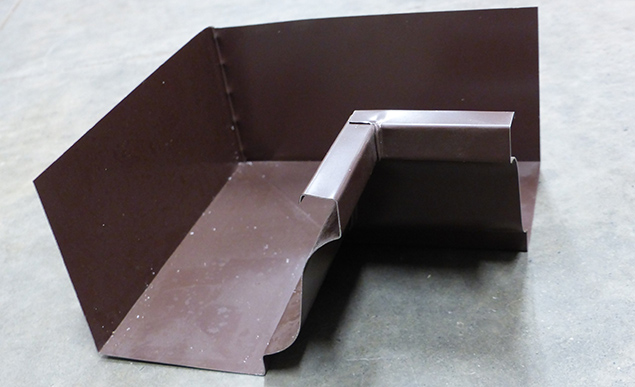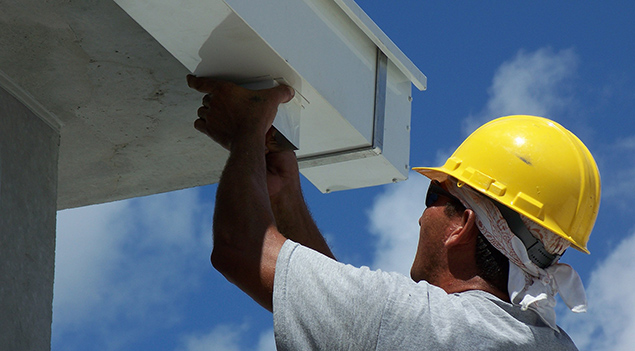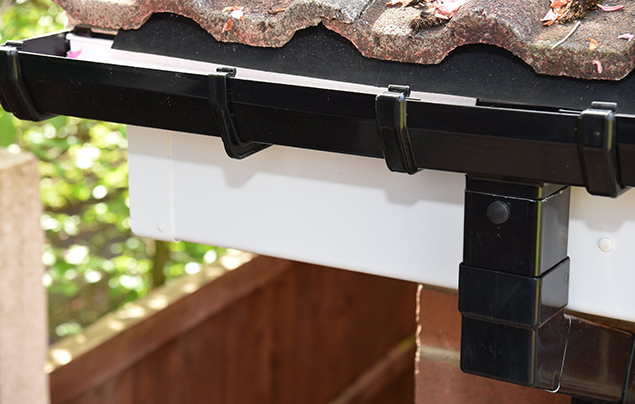4 Styles And 5 Materials Used for Rain Gutters
Types of Rain Gutters
Rain gutters protect your home from serious damage. You have many choices when it comes to style of gutters and materials. Here are some of them.
Rain gutters protect your home by collecting water as it runs off the roof and channeling it away from the house. This keeps water from pooling up next to the foundation. Not every house needs gutters, but if your house does need them, you have numerous choices in terms of both styles and materials.
Read more: How Do Rain Gutters Affect Roof Health?
Styles of gutters
You have several options with regard to the style of your gutters.
K-style gutters

Photo by Stilfehler via Wikimedia Commons [Creative Commons]
The K-style gutter is the most common style for homes built in the last half-century or so. It has one flat side and a flat bottom. The other side of the gutter angles outward and can resemble crown molding.
Since it is so common, this is the cheapest style of gutter. It is also the easiest to install, since the flat side can be nailed directly to the fascia board at the edge of the roof. A K-style gutter can handle more water than most other types of gutters. One major downside is that it can be harder to clean because debris can get caught in the outer side’s multiple angles. Water tends to pool in this type of gutter, which can lead to corrosion.
Half-round gutters

Photo by Mark Gstohl via Wikimedia Commons [Creative Commons]
This style of gutter looks like a cylindrical tube that has been cut in half lengthwise. These were common in homes built more than fifty years ago. Rules or ordinances in historic neighborhoods may still require them.
Half-round gutters are less prone to corrosion because water cannot collect in them as easily. They can, however, collect debris if you don’t use leaf guards. They can be trickier to install because of their shape. You need brackets to attach them to the fascia.
Box gutters

Photo by Ethoseo via Wikimedia Commons [Creative Commons]
Box gutters are larger than other styles of gutter. They are much more common on commercial buildings than on homes. The side that attaches to the building is higher than the outer side, and is designed to tuck under the outermost shingles. While this ensures that water canniot collect between the gutter and the fascia, it means that you must install this kind of gutter during roof installation or reshingling.
Fascia gutters
Most styles of gutter come in sections. If you have to fit two or more sections together, that leaves seams that could leak or corrode. Fascia gutters are custom-built to fit your home, so the only seams are at the corners.
Customization makes this style of gutter very expensive. The same amount of K-style or half-round gutters might only cost half what you’d pay for fascia gutters.
Gutter materials
You also have numerous options with regard to materials.
Vinyl

Photo by Stormcladhomeimprovements via Flickr [Creative Commons]
Vinyl is typically the least expensive material, as well as the easiest to install. It is lightweight, immune to corrosion, and you can paint it different colors. It is also prone to damage in both extreme heat and cold, of which Texas has both. It can bend or crack if subjected to too much force.
Galvanized steel
In the short-term, steel is the strongest material used in gutters. It can withstand all kinds of weather, but even galvanized steel is susceptible to rust after ten to fifteen years. It is also very heavy, so you need to be sure your roof can handle the weight.
Aluminum
Aluminum is inexpensive, lightweight, and fairly easy to install. It is durable and resistant to corrosion. It comes in multiple colors, and you can paint it. On the othe hand, it can warp or bend in hot or cold temperatures.
Zinc
Zinc is expensive but durable. A zinc gutter can last up to fifty years, which is twice as long as aluminum’s lifespan. It is resistant to both rust and warping. Over time, it can develop a distinctive patina that many find attractive.
Copper
 Photo by Joe Shlabotnik via Flickr [Creative Commons]
Photo by Joe Shlabotnik via Flickr [Creative Commons]
Copper is a very durable material that can last a century if it receives the right care. It is also the most expensive material used in gutters. It can be very visually appealing at first. Whether it remains appealing over time depends on whether you like the green patina that copper can develop.
Get proactive about your roof’s health!
RoofCrafters’ skilled and experienced professionals provide unmatched workmanship and service to homes and businesses in the Austin area. Contact us today to schedule your roof inspection.
